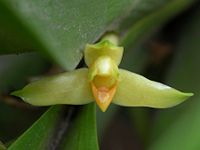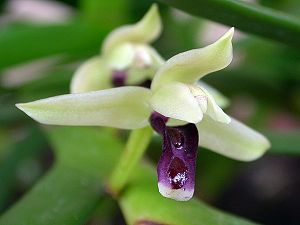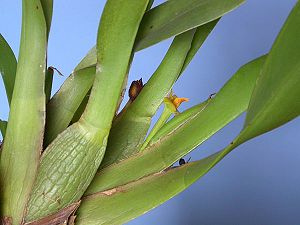Heterotaxis: Difference between revisions
imported>Dalton Holland Baptista |
imported>Dalton Holland Baptista |
||
| Line 64: | Line 64: | ||
==Species== | ==Species== | ||
{{Image|Heterotaxis sessilis23.jpg|left|300px|'''''Heterotaxis sessilis'', pseudobulbs'''<br><small>The core group of ''Heterotaxis'' species are large plants with robust minutely wrinkled pseudobulbs. Some species are not easily separated from each other.</small>}} From the fifteen species submitted to this genus, forteen are accepted<ref name="K"><span style="font-variant:small-caps;">R. Govaerts, M.A. Campacci (Brazil, 2005), D. Holland Baptista (Brazil, 2005), P.Cribb (K, 2003), Alex George (K, 2003), K.Kreuz (2004, Europe), J.Wood (K, 2003, Europe); </span>[http://apps.kew.org/wcsp/qsearch.do World Checklist of Orchidaceae]. The Board of Trustees of the Royal Botanic Gardens, Kew. Access 9th March 2008.</ref> but only six can be easyly recognized. Moreover there is no consensus about the real number of species to be accepted, according to the reference this number varies and different species are accepted. This is a result of the wide range of distribution of ''[[Heterotaxis sessilis]]'', and the disjunction of the areas it does exist. This wide distribution originated several very closely related species that, when found in close areas, are very hard to separate. For instance, the specimens that exist in Florida are a little bit different from the ones of Mexico, the ones from Mexico, a little bit from the ones of Panama, and so forth, thus, when two plants from very distant places are compared they show many differences although there is a continuous change and numerous variations in the middle, making very hard to establish when a species ends and another one starts. ''Heterotaxis sessilis'' may be considered in fact a superspecies, or as it is named today, a complex of cryptic species. The variations one can see among all these closely related species are, thickness and length of the leaves, shape and size of the pseudobulbs, shape of the calli on the labellum of their flowers, flower colors and length of the inflorescence. Different combinations of each one of this variations get different species names. | |||
Despite the difficulties along this group of species related to ''H. sessilis'', not all ''Heterotaxis'' species are so confusing and some are actually very easy to recognize. ''Heterotaxis'' can be divided in four clearly distinct groups. | Despite the difficulties along this group of species related to ''H. sessilis'', not all ''Heterotaxis'' species are so confusing and some are actually very easy to recognize. ''Heterotaxis'' can be divided in four clearly distinct groups. | ||
Revision as of 21:23, 9 March 2009
| Heterotaxis | ||||||||||||||||||||
|---|---|---|---|---|---|---|---|---|---|---|---|---|---|---|---|---|---|---|---|---|
 Heterotaxis sessilis
| ||||||||||||||||||||
| Scientific classification | ||||||||||||||||||||
| ||||||||||||||||||||
| Type species | ||||||||||||||||||||
| Heterotaxis crassifolia Lindl. 1826 | ||||||||||||||||||||
| Species | ||||||||||||||||||||
| ||||||||||||||||||||
| Synonym | ||||||||||||||||||||
Heterotaxis is a genus of orchids formed by a group of circa fourteen neotropical species which previously were considered part of genus Maxillaria. They are strong epiphytic plants with shiny dark green leaves which make a showy display making a very good first impression but that end disappointing because of their small flowers, usually yellow, which, because of their short inflorescences, hide between the foliage and can hardly be seen. Although the species that belong to this genus are easy to identify, because they are highly variable and very similar to each other, to differentiate them is hard, with very few exceptions.
Distribution
The range of distribution of Heretotaxis is wide, particularly because of the type species, H. sessilis, which can be found from South Florida, Caribbean and Mexico, spread through all Central America countries to tropical America, reaching Bolivia and South Brazil.
All species are mostly epiphytic, despite some can occasionally be seen living as litophytes on shady and humid cliffs. The species of Heterotaxis hardly ever are found living under full sunlight, being more common under the shelter and shade of trees. They are strong plants that can adapt to different environment conditions, since very wet forests of Florida and Amazon, to cloudy mountain forests in the Andes and along Serra do Mar mountains in Brazil, and even in dry jungles of highlands of Central Brazil. Some species, like Heterotaxis equitans can be found also living at the edges of the jungles were the get more light than most of other species of this genus.
Heterotaxis species are easy to grow provided they are potted in a well drained substrate, able to get dry few hours after watered, under medium light, in a well ventilated place preferably humid, or at least humid during the night hours.
Description
Heterotaxis species can be distinguished form all other Maxillariinae by three main features:[1]
- The floral pedicel is wider than the other internodes of the peduncle.
- The junction of the column and the pedicel is slanted at an angle of 45º.
- The sepals and petals have a subapical mucron.
Heterotaxis are comparatively large and robust plants among orchids. According to their morphologic characteristics they can be split into two main groups, identifiable at the first glance, all bearing comparatively minute flowers growing from several or few inflorescences produced sequentially from each leaf axil, almost any time of the year. As any species once subordinated to Maxillaria the inflorescences are lateral, they hardly are taller than the pseudobulb and often are very short, bearing just one flower. All species have small thick flowers, which frequently do not open entirely, ordinarily yellowish, but also orange or white, sometimes with purple-bluish, lilac or brown-red spots. A thickening or variable calli on the center of the lip are common, sometimes covered by waxy glandular trichomes that attract pollinators, mostly meliponine bees.[2] Their column is very short and the fruits show lateral dehiscence.
The core group of Heterotaxis species present sympodial growth and short rhizomes, with unifoliate laterally compressed, minutely wrinkled, pseudobulbs, protected by several foliar stealths of glossy foliage. The pseudobulbs are minutely wrinkled bearing one leaf at the apex, exceptionally two, which may be very long or sometimes shorter, depending on the species or whether when the plants receive plenty of light. Here belong the majority of the species and the type species.[3]
The second group entirely lacks pseudobulbs, showing a pseudomonopodial growth with flat distichous leaves. One species, Heterotaxis equitans has ascending habit and is vegetatively very similar to some Vanda and Angraecum species. The other species, which the most noted member is Heterotaxis valenzuelana have very long rhyzome and their leaves are highly flattened forming a sort of fan, thus can be vegetatively compared to Ornithocephalus species. The leaves of this later subgroup, unlikely all the other Heterotaxis species, are not glossy; they seem to be covered by white dust. Because these obvious vegetative differences Frederico Hoehne proposed the genus Marsupiaria for them in 1947.[4]
Taxonomic notes
John Lindley proposed this genus in 1826, when he described Heterotaxis crassifolia, its type species. Four years later, he described another new genus and species, Dicrypta baueri, which is today considered a synonym of the former. Within a few years, contemporary and subsequent taxonomists described or transfered all known species to Dicrypta. During the decade of 1850, Heinrich Gustav Reichenbach decided that there was no reason enough to maintain these species separated and moved them all to Maxillaria.
As mentioned before, in 1947 the Brazilian Botanist Frederico Carlos Hoehne suggested a new genus, Marsupiaria, to subordinate the species lacking pseudobulbs. Later taxonomists, such as Garay, Senghas, Brieger, Illg[5] and Pabst, followed Hoehne and, one by one, along the years, subordinated all species of this group today known to Hoehne's genus.
Finally, Fábio de Barros published a review in 2002 reestablishing the ancient genus Heterotaxis, the first proposed by Lindley. On this publication he reinstates the former name of the type species and makes five new combinations.[6] Three years later Ojeda and Carnevale, supported by phylogenetics studies, added eight species more to the genus, six were new combination and two were new species.[7]
Heterotaxis most closely related genera, both also once considered to be part of a large genus Maxillaria are Nitidobulbon and Ornithidium. Both the flowers of Heterotaxis and Nitidobulbon are distinctly fleshy usually possessing fiber bundles in the sepals and petals.[1]
Brieger and Illg considereed Nitidobulon nasutus as a member of Heterotaxis group,[5] but this species belongs to a separate clade along with N. cymbidioides.[7]
Despite morphologists and phylogenists are in agreement with the new classification of these fourteen species, so far nurseries and growers keep using their former names and old synonyms, mostly Marsupiaria e Maxillaria.
Species
From the fifteen species submitted to this genus, forteen are accepted[8] but only six can be easyly recognized. Moreover there is no consensus about the real number of species to be accepted, according to the reference this number varies and different species are accepted. This is a result of the wide range of distribution of Heterotaxis sessilis, and the disjunction of the areas it does exist. This wide distribution originated several very closely related species that, when found in close areas, are very hard to separate. For instance, the specimens that exist in Florida are a little bit different from the ones of Mexico, the ones from Mexico, a little bit from the ones of Panama, and so forth, thus, when two plants from very distant places are compared they show many differences although there is a continuous change and numerous variations in the middle, making very hard to establish when a species ends and another one starts. Heterotaxis sessilis may be considered in fact a superspecies, or as it is named today, a complex of cryptic species. The variations one can see among all these closely related species are, thickness and length of the leaves, shape and size of the pseudobulbs, shape of the calli on the labellum of their flowers, flower colors and length of the inflorescence. Different combinations of each one of this variations get different species names.
Despite the difficulties along this group of species related to H. sessilis, not all Heterotaxis species are so confusing and some are actually very easy to recognize. Heterotaxis can be divided in four clearly distinct groups.
- The one mentioned before can be called Heterotaxis sessilis complex, it is characterized by pale yellow to bright yellow or orange flowers, with labellum of same colors or deeper, and short or long inflorescences. They are eight species, Heterotaxis brasiliensis, Heterotaxis discolor, Heterotaxis fritzii, Heterotaxis maleolens, Heterotaxis santanae, Heterotaxis schultesii, Heterotaxis sessilis and Heterotaxis villosa.
- Heterotaxis violaceopunctata complex: species with pseudobulbs; withe ordinarily white flowers, exceptionally yellow or cream, always with much darker labellum or sometimes spotted, generally of purple; and long or shortinflorescence. There are three species: Heterotaxis proboscidea, Heterotaxis superflua and Heterotaxis violaceopunctata.
- Heterotaxis valenzuelana complex: species without pseudobulbs, the plants are fan shaped; pale yellow to bright yellow or orange flowers, with labellum of same colors or deeper, and short or long inflorescences. Two species belong to this group, Heterotaxis microiridifolia and Heterotaxis valenzuelana.
- Heterotaxis equitans. It is a very distinctive species of neotropical orchid for this plant looks like very much with monopodial species from Asia and Africa. They do not have pesudobulbs, their flowers are white or very light pale green, with labellum of very intense and dark blue-purple.
References
- ↑ 1.0 1.1 Whitten, W.M., M. A. Blanco, N. H. Williams, S. Koehler, G. Carnevali, R. B. Singer, L. Endara, & K. M. Neubig.. 2007. Molecular Phylogenetics of Maxillaria and Related Genera (Orchidaceae: Cymbidieae) Based Upon Combined Molecular Data Sets. American Journal of Botany 94: 1860-1889.
- ↑ Singer, R.B., A.J. Marsaioli, A. Flach, and M. Gomes-Reis. 2006. The ecology and chemistry of pollination in Brazilian orchids: recent advances. In J. A. Teixeira da Silva [ed.], Floriculture, ornamental and plant biotechnology: advances and topical issues, vol. IV, 570–583. Global Science Books, Isleworth, Middlesex, UK.
- ↑ Blanco, M. A. G. Carnevali, W. M. Whitten, R. Singer, S. Koehler, N. H. Williams, I. Ojeda, K. Neubig, & L. Endara. 2007. Generic Realignments in Maxillariinae (Orchidaceae). Lankesteriana 7(3): 515-537.
- ↑ Hoehne, FC. (1947). Marsupiaria in Arq. Bot. Estado São Paulo, n.s., f.m., 2: 69.
- ↑ 5.0 5.1 Brieger, FG, and RD Illg. (1972). O grupo Heterotaxis do gênero Maxillaria Ruiz & Pavón (Orchidaceae). Anais da Sociedade Botânica do Brasil, 238 Congresso Nacional de Botânica, 93–99. Universidade Federal de Pernambuco, Recife, Brazil.
- ↑ Fábio de Barros. (2002). Notas taxonômicas para espécies brasileiras dos gêneros Epidendrum e Heterotaxis (Orchidaceae), Hoehnea 29: 112
- ↑ 7.0 7.1 Isidro Ojeda, Germán Carnevali Fernández-Concha & Gustavo A. Romero-González. (2005). New Species and Combinations in Heterotaxis Lindley (Orchidaceae: Maxillariinae) - Novon: A Journal for Botanical Nomenclature, Volume 15, Issue 4, pp. 572–582.
- ↑ R. Govaerts, M.A. Campacci (Brazil, 2005), D. Holland Baptista (Brazil, 2005), P.Cribb (K, 2003), Alex George (K, 2003), K.Kreuz (2004, Europe), J.Wood (K, 2003, Europe); World Checklist of Orchidaceae. The Board of Trustees of the Royal Botanic Gardens, Kew. Access 9th March 2008.


